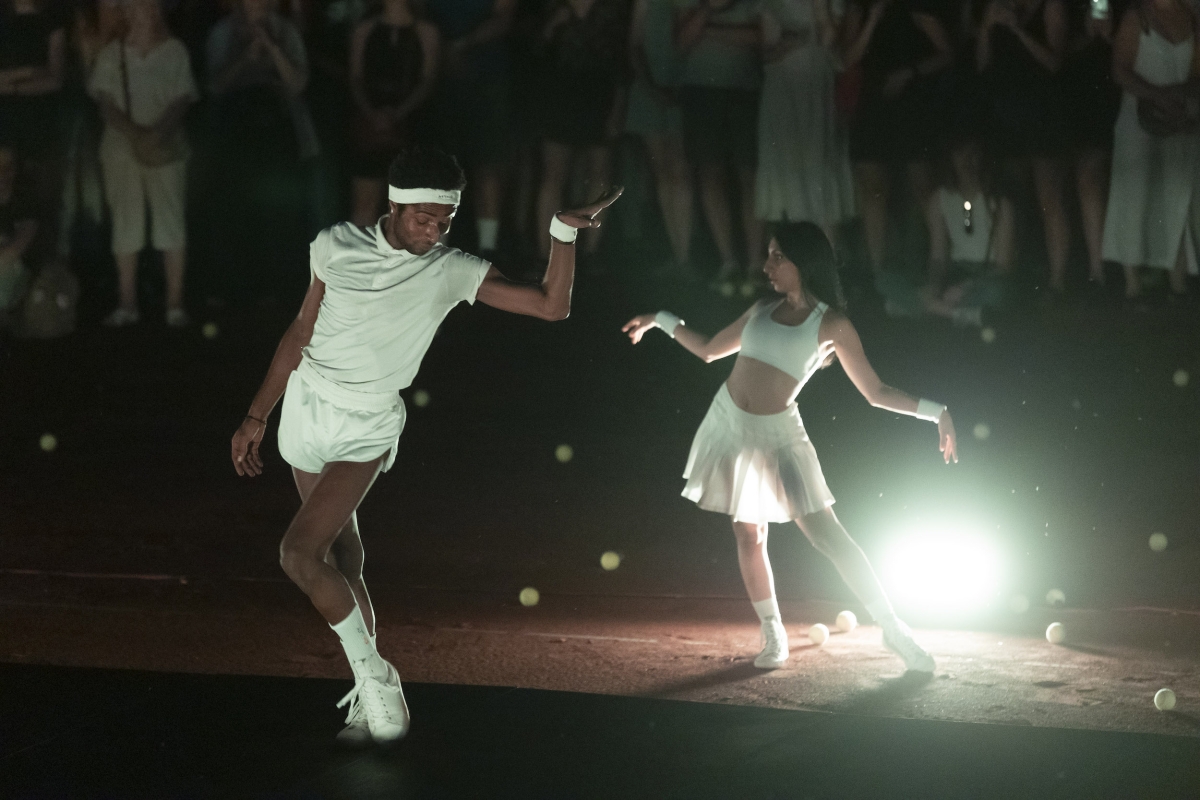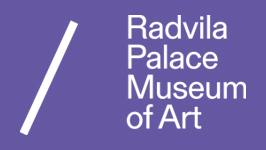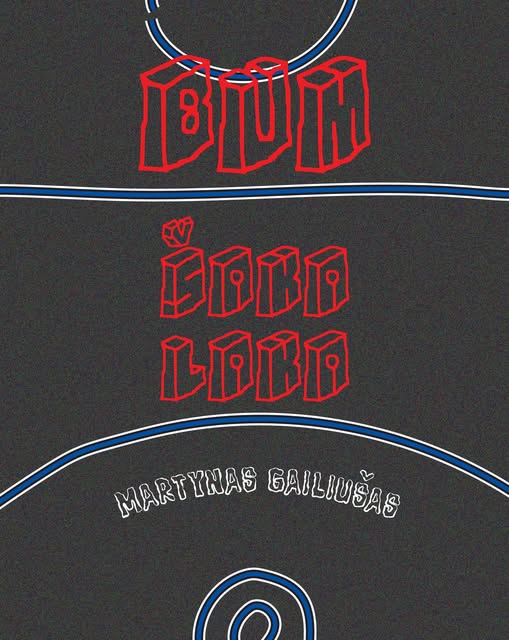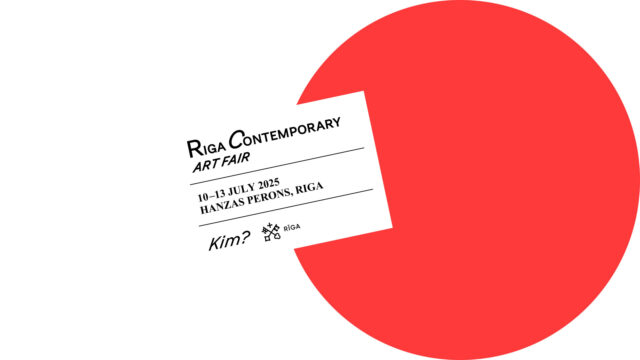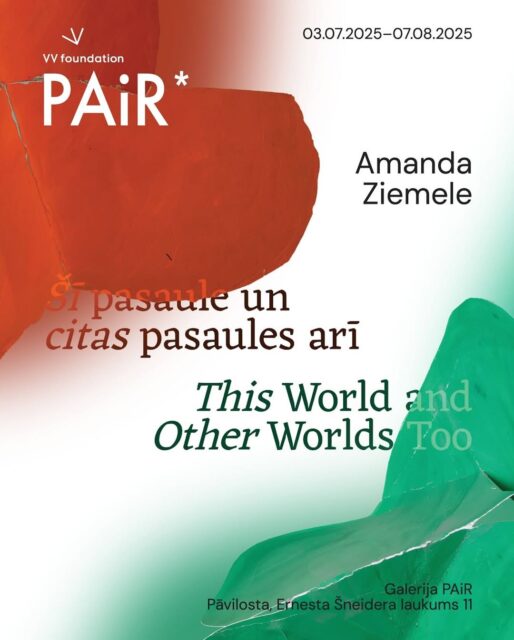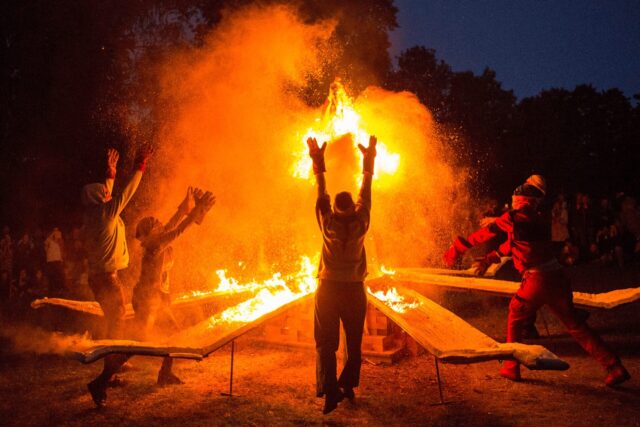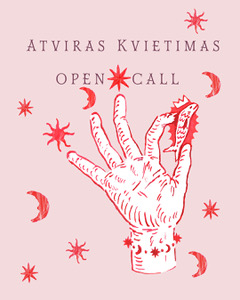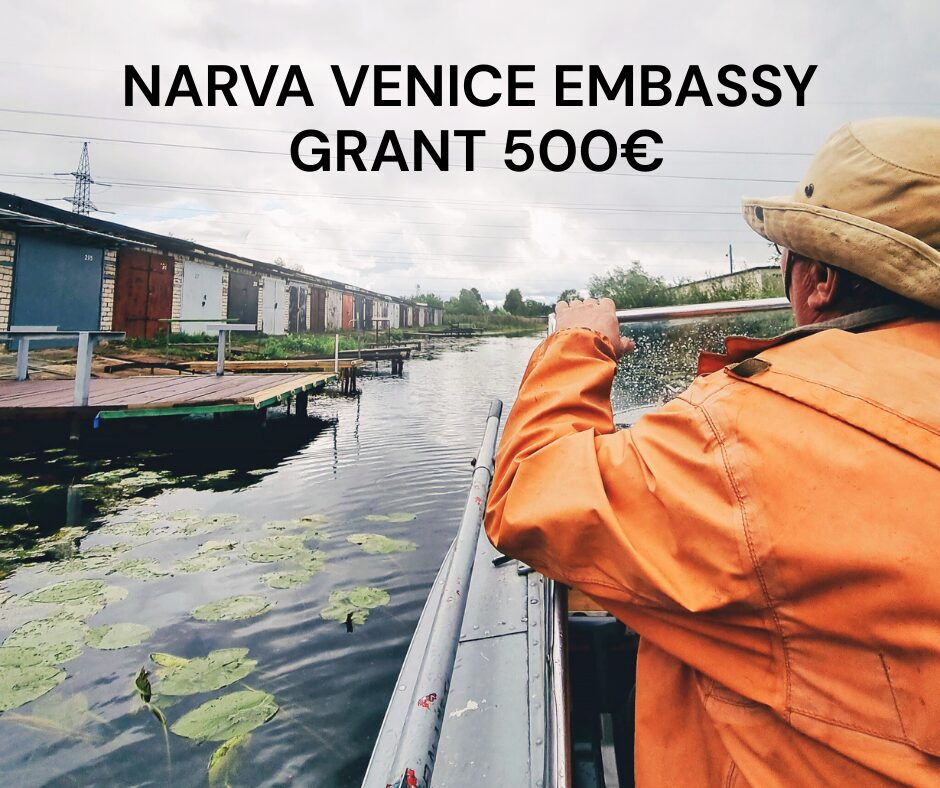A month has passed since the first Vilnius Biennial of Performance Art made good on its promise to activate the city over two weeks. Layers of dust continue to settle, as they always have done, and a question continues emerging in my mind: …and?
In excited, indifferent and confused conversations following the performances, this was the question I noticed myself asking repeatedly. Now, I don’t mean it as a disparaging remark. It’s a genuine inquiry into the impact and legacy of the biennial. This question wanders the city looking for ‘the point’ (a mysterious place they keep hearing about; they think it must be a club) until eventually giving up without ever elaborating or making a confident statement.
Having seen all of the 17 (+1) performances, I decided it would be too tedious of a read to go through them all at once. So, I deconstructed this question into three parts— … / & / ? — as an arbitrary, though ultimately meaningful, way to discuss the works.
Let’s begin with the ellipsis. These are works that have a promising premise but trail off without finishing or certainty of the point they’re making, suggesting the existence of something more but relying perhaps too much on the inventive imaginations of audiences to fill in the gaps.

Dovydas Laurinaitis
Gimbutas Street Band / Laima Kreivytė, Eileen Myles and Justė Kostikovaitė
Gathered in front of Pamėnkalnio Gallery, we are informed the adjacent Jogailos Street is in dire need of a name change. Rather than evoking and reaffirming the Lithuanian Grand Duke who converted Lithuania to Christianity (thanks for that, by the way), we should rededicate this street to Marija Gimbutas, an anthropologist and feminist icon. As a further claim to her name’s legitimacy, she even had a flat at 11 Jogailos Street.
The five performers in front of us—three readers in the middle, a feather-light drummer to the left and an extravagantly dressed woman with a mask around her neck to the right—explain they are not only a band, but also bandits.
I don’t think they’re embodying what they’re saying.
Laima, Eileen and Justė read from the papers in their hand, attempting to catch the careful rhythm and occasional syncopation that structure the text, unable to fully find the flow as it’s clear they haven’t rehearsed or become familiar enough with the material. There are stumbles and pauses, but it all still somehow manages to feel staged rather than raw.
I wonder if this is a way to queer up performing, though? Not being perfectly prepared or rehearsed. It can be a space for people to come together and then things happen afterwards.
If I would want to queer painting, for example, I would still use a canvas and paint, finding ways to twist those elements. In performance, body, presence and energy are the materials, and I don’t feel they are committing to, less so queering those things.
Isn’t this performance already effective in generating this idea within us?
Perhaps their aim was to explore performance as protest, yet this protest is quiet and unsure of itself. I can’t say I feel inspired enough to petition the municipality for this name change. They fall short of their promise of being a band or bandits. There is neither congruent musicality nor discordant angst.
I guess they were talking about naming street names? After a certain person… but I don’t know who this person is.

Gimbutas Street Band. Laima Kreivytė, Eileen Myles and Justė Kostikovaitė. Photo: Andrej Vasilenko

Gimbutas Street Band. Laima Kreivytė, Eileen Myles and Justė Kostikovaitė. Photo: Andrej Vasilenko

Gimbutas Street Band. Laima Kreivytė, Eileen Myles and Justė Kostikovaitė. Photo: Andrej Vasilenko
A Guiding Light Part 2 / Liam Gillick and Anton Vidokle
Heading towards the turntable of Lithuanian Railways, I see a crowd of people compressed behind a metal railing. I panic, thinking I won’t be able to see a thing but my friend weaves through the crowd to the front, creating a path. At the front, I feel the tightness of collective anticipation mixed with slight annoyance.
A volunteer wearing an orange safety vest comes up to me and asks if I’d like to go to the other side for the measly price of two hours of my life being filmed. I sign the form in my hands without reading and receive a yellow vest. Walking around the turntable, I see tables set up with snacks and wine bottles I soon learn are filled with fruit juice.
A jazz band climbs atop the turntable with their instruments. I’ve been told they will play fragments of various songs of resistance from across the globe.
Action!
The sound of the clapper cues the band to play and the turntable to rotate… for a few seconds. It stops. People wander around, checking, asking. Starting, stopping, starting, stopping. This continues for the entirety of the two hours.
Revoliucija neprasideda
As the sun sets, the stage lights surrounding us emerge into view. I wonder if it is the audience who are creating the performance. On one side, we have the bourgeois: eating, drinking, chatting and laughing while the revolution attempts and ultimately fails to start; on the other, we have ‘the people’ whose hunger and annoyance can only grow.
But was it part of the concept, or did they just set it up for the ‘VIPs’?
I heard the original idea was to have tables all around, but they couldn’t do it due to safety restrictions.
So that wasn’t the idea? Cancelled…
Well, this context emerged regardless and it’s coherent with the work, so can you really judge it on the intention? Over the two hours, I periodically venture to see how many people are left on the other side; each time, their numbers wane. I wave to them. Is this action provocative? Do they wonder why we are here and they are there?
It’s like candy you can’t reach…
What if they push past the metal fence and rush to the centre of the revolution? What if they kill us? Would that be the performance?
Returning to my comfortable table, I remark that the experience would’ve been much worse from the other side. I grow weary of the contract I made but see it through. While the initial impact was strong, the work doesn’t go anywhere; it just keeps us in this limbo, exhausting us. Was that the point? To grow our hunger for change by wearing down our patience?
We’re just waiting for ‘Bunda jau Baltija!’.

A Guiding Light Part 2. Liam Gillick and Anton Vidokle. Photo: Andrej Vasilenko
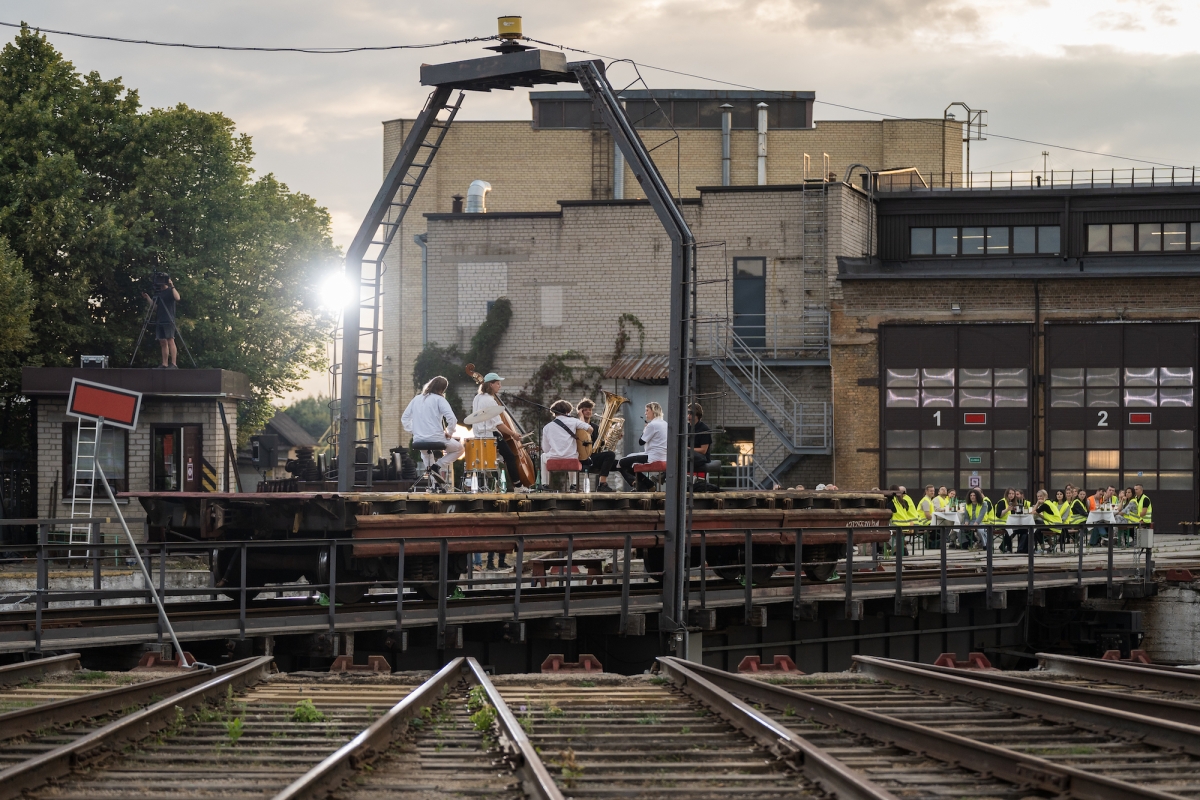
A Guiding Light Part 2. Liam Gillick and Anton Vidokle. Photo: Andrej Vasilenko
My body, this paper, this fire / Pedro Barateiro
In the dark, grey open space of the National Gallery of Art, rows of chairs surround a blank LED screen and microphone on the floor. A glitching newscast announces the start, showing some kind of confrontation with the police—where is this?
Pedro enters and picks up the microphone. He has a phone in his hand. I really hope he won’t be reading off his phone.
He starts reading off his phone… though not always. There are moments when he’s reciting from memory and sweeps his gaze across our faces like the subtle breeze of a moving hand. It’s such a simple yet fundamental way of establishing intimacy so I’m confused why he wants this barrier if he doesn’t need it.
The video is a bit illustrative, no?
We learn this is footage of a protest against tuition fees in front of the Portuguese parliament, which he recounts being at, as another person enters and embraces Pedro in a hug. They shift their bodies slowly through the space while he continues reading, the screen behind them playing distorted and edited together footage. In the relation of body to screen, where is the focal point? Or is the point a lack of focus? Is he creating these distances to feel safe?
It’s interesting how we’re thinking for the artists.
Occasionally, they get entangled in the microphone cable, but Pedro always kicks it away, allowing it to distract him from reading. The exercise of control. Why run away from this unintended encounter?
As with a lot of the text-based performances in this biennial, the quasi-monotone, ‘neutral’ way of reading lacks the emotion to frame the meaning so the words blend and disappear into peripheries of awareness. Where are we in it? What was he talking about again?
The text feels like the most important words in contemporary art at the moment, but I really like the hugging. It’s a strong move to hug during a protest, it could be a sensitive move… but also out of desperation.
Towards the end, the video shows Pedro doing the same performance, except amid a crowd. It makes me wish we were a crowd for him to get lost in, not a seated audience in a neat arch.
I was expecting him to ask us to hug each other. He created an environment where we might’ve actually done it.
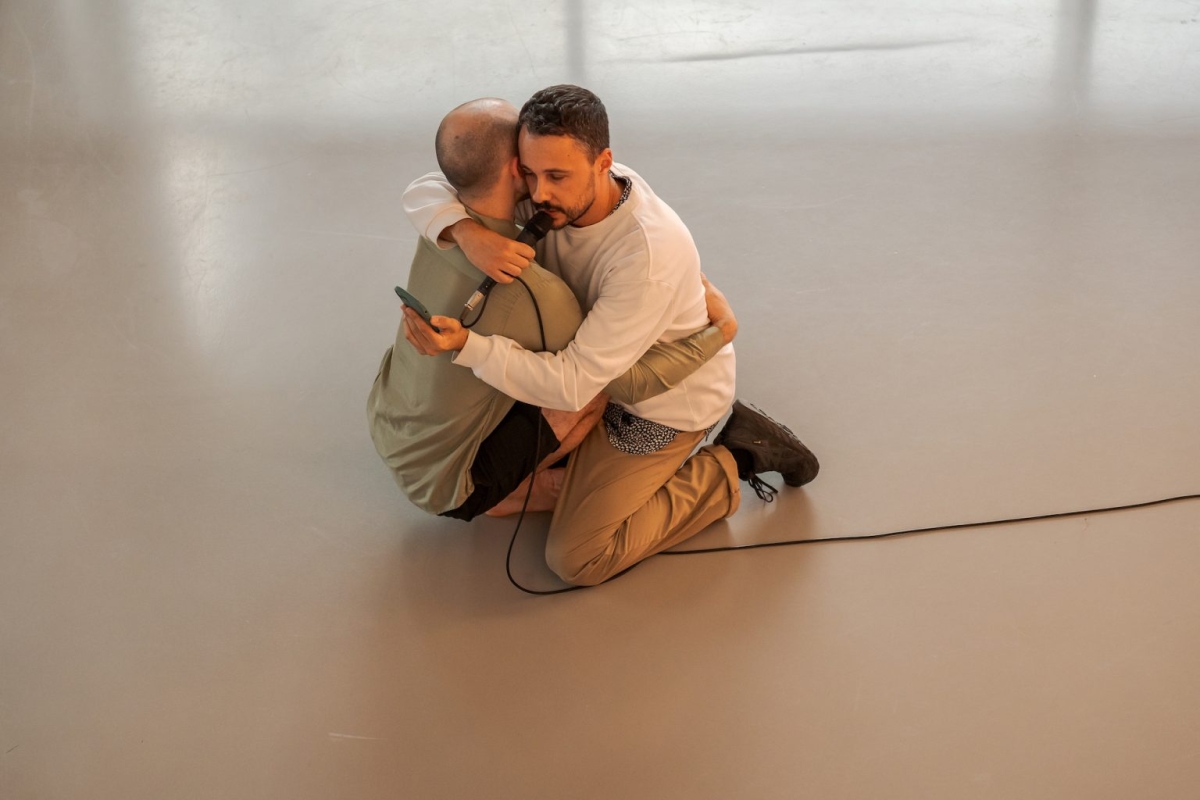
My body, this paper, this fire. Pedro Barateiro. Photo: Andrej Vasilenko
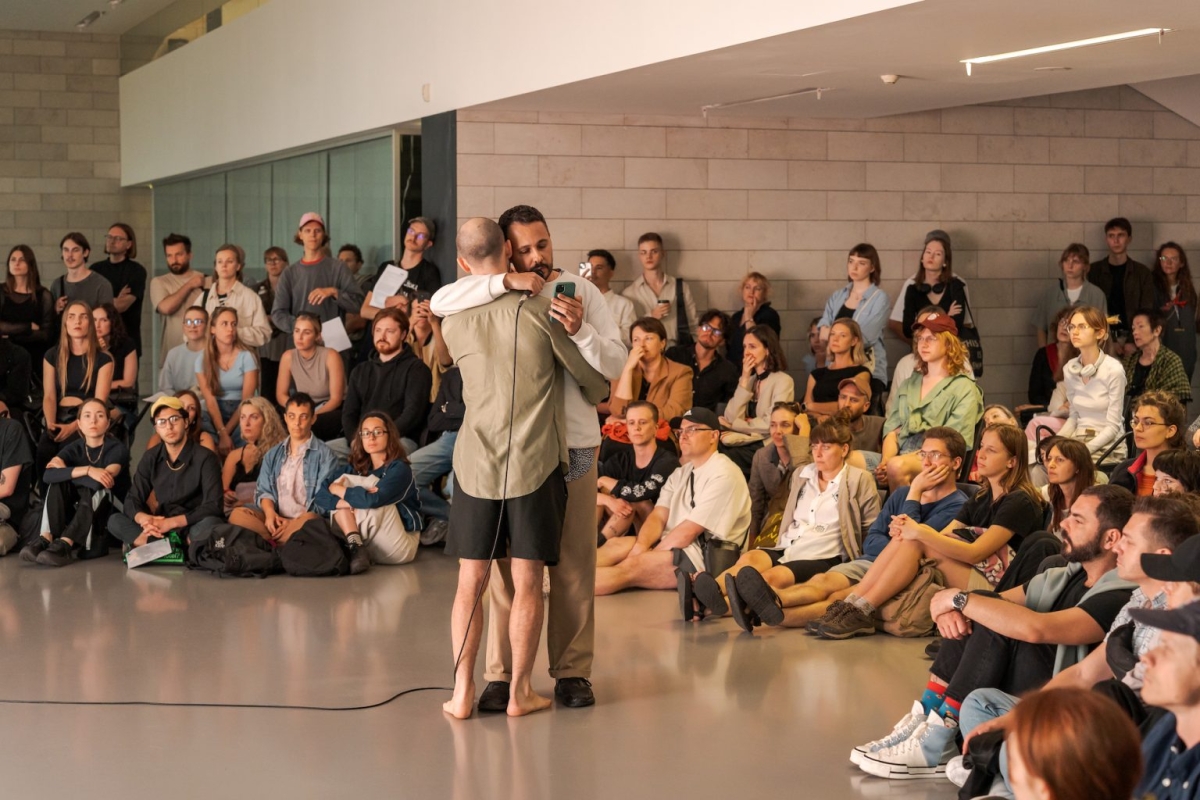
My body, this paper, this fire. Pedro Barateiro. Photo: Andrej Vasilenko

My body, this paper, this fire. Pedro Barateiro. Photo: Andrej Vasilenko
Song Sing Soil / Eglė Budvytytė and Marija Olšauskaitė
Atop a Venn trampoline of three circles, performers hibernate. Tattered lines separate their frozen bodies. In time, they begin cautiously moving through and surveying, mechanical and ritual-like. They remind me of glaciers drifting across an ocean.
The light above makes it feel like they are particles in between the air.
A vaguely dystopic soundtrack is playing and through the distortion, a few lines land in my lap.
Elon Musk, may you become insignificant… give me yourself to compost… you don’t have much time… harm the economy… the world belongs to those who work less…
Clearly, they are critiquing capitalism (who isn’t?) and… moving slowly to illustrate this notion of rest as resistance? The pace stays at this even viscosity throughout and without any substantial thematic or choreographic development, chips away at the initial atmosphere of this enigmatic encounter that felt as if we were in some liminal pocket dimension. Instead, reality gradually makes itself known, reminding us we are actually inside Menų spaustuvė.
I like that they didn’t bounce on the trampoline. That was my first expectation.
I wonder why they used it then? Perhaps to dictate a particular way of moving… trying to escape the feeling of sinking or forever stuck in the sensation of ‘climbing out’. Like walking up an escalator going down.
The movement of the performers is hardly virtuosic and the choreography is relatively simple. It makes me wonder if the creators were trying to inhabit their message in the process, resting without the need for over-exertion in the pursuit of complexity and intricacy.
The performance finishes with the performers half-heartedly hopping and shuffling through the seated audience around the Venn trampoline—it’s quite funny but everyone is so serious. Maybe it’s not meant to be funny.
So this is the awkward moment where no one knows if the performance is over or not. Who’s going to break first?
Just silence and the sound of the performers’ feet on the floor. In the end—what will you do?
Clap.

Song Sing Soil. Eglė Budvytytė and Marija Olšauskaitė. Photo: Andrej Vasilenko

Song Sing Soil. Eglė Budvytytė and Marija Olšauskaitė. Photo: Andrej Vasilenko

Song Sing Soil. Eglė Budvytytė and Marija Olšauskaitė. Photo: Andrej Vasilenko
Solar / Rūta Junevičiūtė
A series of fabric squares hang from the ceiling in a line, depicting rectangles, squares, circles and fluid mountainous lines in pastel colours. It reminds me of some bedsheets I had when I was a child. The audience frames the tight rectangular space, creating a thin walkway for the performer, who I later learn isn’t Rūta.
I get down on the floor to see better as my view is obscured by these fabric panels (was the audience even supposed to be at this end or are we just over capacity?).
She starts vocalising and building up to a song that describes her ‘mother earth’ and ‘mother sun’ with all their masochistic, narcissistic, paranoid and depressive tendencies. Her feet grow heavier, accompanying her singing. All I see is her back. She has healthy-looking, long blonde hair.
People around me start leaving. Is it the heat? The lack of air? The room is musty. Their exit shifts the atmosphere.
I didn’t even notice from the other side.
She gets to the other end and turns around. I finally see her face. She repeats a movement of crossing her arms and switching into what looks like a fighting stance. Is she saying no to climate change? This mannerism is controlled, tense, decisive and constant. I wish it had grown, that there was more exploration and nuance in it, although there is something admirable about it being unwavering.
For me, this kind of movement… I’ve seen it in every performance, I feel like everybody does something similar.
Again, the shuffling of bodies leaving behind me, whispers.
They don’t know where they came…
So far, she is closed off to the rest of us. Where’s the generosity? Who is she performing for? I don’t feel anything. She gets on the floor and into the arms of a ‘stranger’ who strokes her head. The photographer moves into position; everything pauses until the photo is taken… and then it continues.
Halfway through, she demolishes her previously walled-off demeanour and acknowledges our presence by speaking to us. What I thought was a post-performance speech turns out to be a monologue about her physical and spiritual journeys surrounding rest, performed with some physical theatre flourishes.
Even though this monologue breaks all of the tension and atmosphere the performance was building until now, I’m actually connecting and feeling something (albeit fighting my cynicism in the awareness of how rehearsed this honest moment is, but still).
The performance is made up of very well-divided segments, yet they don’t quite go together or add up to more than the sum of their parts. Why not just the text? A fear of being too simple?
It is quite cryptic… I need to think about it.
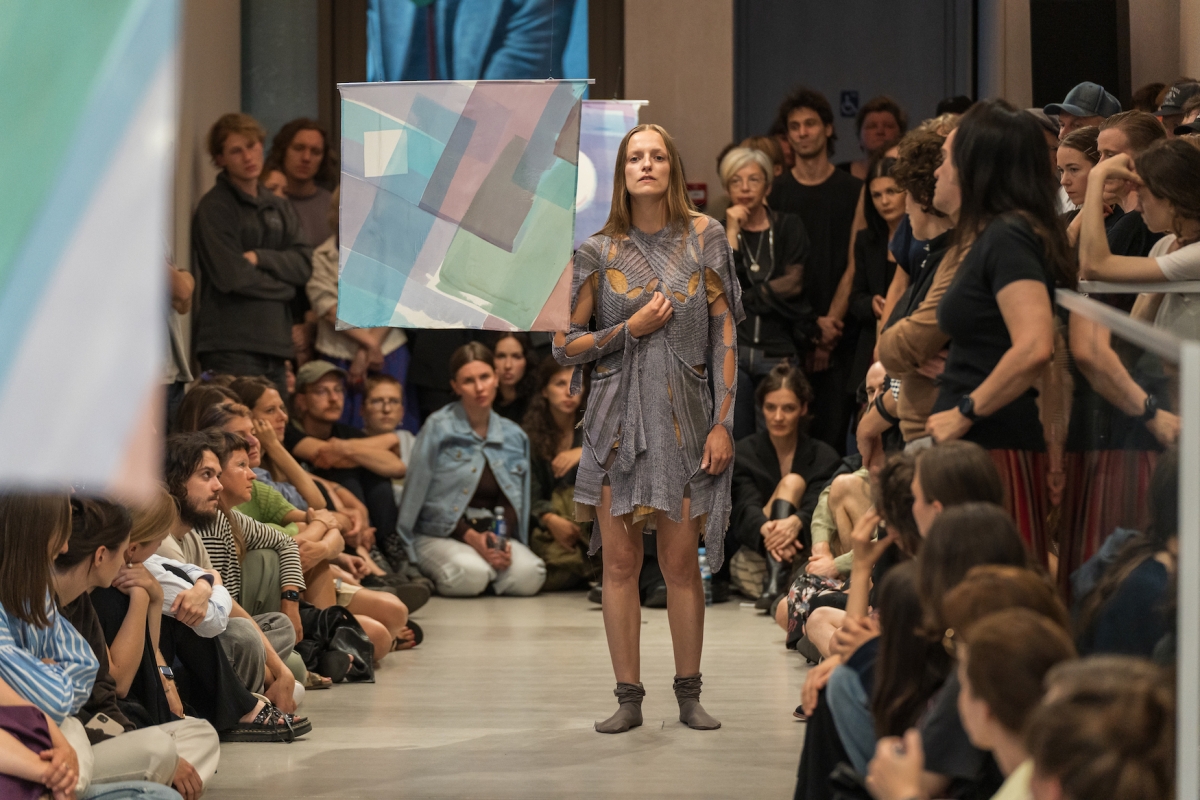
Solar. Rūta Junevičiūtė. Photo: Andrej Vasilenko

Solar. Rūta Junevičiūtė. Photo: Andrej Vasilenko
Kiosk Kłącza (Crisis Kiosk) / Yulia Krivich, Marta Romankiv, Weronika Zalewska
Kalvarijų turgus is swarming with ageing people doing their shopping. Away from the usual yellow stands, an L-shaped table is set up with a dusty pink tablecloth on top. There are bowls of various food items and a yellowish drink in a large glass dispenser. Almost every person passing by casts it a cautious but curious glance.
Ką čia siūlot?
There is writing on the tablecloth inviting people for an exchange—simple Ukrainian food for survival recipes. It even advises that you can call a family member or ask a stranger if you don’t know (like on ‘Who Wants to Be a Millionaire?’).
A small group of curious people is forming. The performers stand behind the table ready to explain the invitation and prepare a paper plate for those who write something. They are wearing all black, like a high-school drama class. Again with this ‘neutrality’. Why not something more vibrant? Considered? Performative? Contextually relevant? There’s no real world-building happening here. They stand, slightly shy and smiling, a bit like unenthusiastic salespeople.
How do these encounters factor into the economics of the market? Is the work even trying to say anything about this context? They explain the food items are common things from Ukraine that are now scarce due to the war yet here they have plenty. Why not experiment with scarcity?
I look at what people have written: a mix of legit recipe suggestions (‘troškinys su meile’) and advice like looking to god or managing your expectations. Quite a few stories about family members being sent to Siberia. One that mentions having to eat an entire herring to survive, not wasting any parts.
Someone comes up to me and asks what’s happening, I direct them to read the instructions. They say they don’t have time and walk away.
I finally go up and take the invitation. I speak to one of the artists about what to write—do you want advice or stories?
Both
I only have advice today. It feels wrong to connect advice for a personal struggle with the struggles of Ukrainians but they are very encouraging for me to share whatever I have.
While I write, they prepare a paper plate and explain on it is sunflower paste on black bread, barley with beetroot and carrots, a chunk of corn cob and kvass (made from Yulia’s grandmother’s recipe).
I eat the food. It needs salt, which is on the table, but I don’t take any. I continue watching the scene while eating and wonder if the exchange changed how I feel. Has my participation transformed me, in however small of a way?
I don’t think so. I throw my plate in the bin and leave, smiling.
I tried to go but they had already given all the food away…

Kiosk Kłącza (Crisis Kiosk). Yulia Krivich, Marta Romankiv, Weronika Zalewska. Photo: Andrej Vasilenko

Kiosk Kłącza (Crisis Kiosk). Yulia Krivich, Marta Romankiv, Weronika Zalewska. Photo: Andrej Vasilenko

Kiosk Kłącza (Crisis Kiosk). Yulia Krivich, Marta Romankiv, Weronika Zalewska. Photo: Andrej Vasilenko
Egghorsecizmus / Robertas Narkus
In a cramped conference room of an apparently desolate business centre (it’s after work hours), rows of chairs encircle Robertas, who is sitting with his back to us, eyes closed, wearing a head mic, a smiley drawn on the back of his bald head.
Around him is a messy scenography of a mirror, chair, statue, stacks of beer cans (some crumpled ones on the floor), lights, a projector and a low, rumbling sound. I look down, realising the room is carpeted, which makes me feel like I’m in his living room. Waiting for us on the chairs are pairs of those early 2000s headphones with the scratchy synthetic material on the speakers.
Someone in the foyer told me it would be about a mid-life crisis. I heard he would be doing stand-up. His voice, broadcast into each individual set of ears, tells us he will share his life stories and intimate moments, and that his artworks are attempts to overcome fear. So this is the artist being brave, going outside his comfort zone.
We missed the content because it was in Lithuanian.
As he’s talking, some chuckle, others laugh, many are silent; I can’t say I get it. One of his jokes is about how children are best around six because after that, their arms become longer and they start stealing your socks and pants, using up your perfume…
Maybe it’s good I didn’t hear.
I wonder if this material is meant to be purposefully unfunny but he’s not delivering it like a stand-up comedian who is confidently bombing. There’s not much performing happening on his part and the delivery doesn’t follow the emotion of what he’s saying (but maybe I just want this so I could more easily understand or even laugh).
Who is this work for? I feel like you need a lot of context of Robertas as a person to find this funny. It’s good that a lot of his audience are friends. Many people didn’t even manage to get inside due to the limited space.
The performance? It is very Robertas. I love that he’s doing it. It’s his first-ever stand-up.
The text doesn’t follow the conventional structure of jokes with a set-up and a punchline, it’s more of a collection of stories with occasional humorous flourishes and poetic touches. I do chuckle when he tells us about the first time he understood he was a white, heterosexual male. That must’ve been a difficult process of acceptance for him.
After he finishes, he stands up to talk to some audience members and in moving closer to the projector, casts a huge shadow that he stands within. I think this image best describes how I feel about the performance.
Some of Robertas’ friends said it was very cute and brought up memories of being in kindergarten with him. So for some people, it was stand-up comedy. But you can’t just make it for your friends.

Egghorsecizmus. Robertas Narkus. Photo: Marius Žičius

Egghorsecizmus. Robertas Narkus. Photo: Marius Žičius

Egghorsecizmus. Robertas Narkus. Photo: Marius Žičius
Throwing Balls at Night / Jacopo Miliani
From an observation bridge above a tennis court, I see a myriad of tennis balls scattered on the ground. The brick red colour is dimming into darkness, only lifted by the hue of the six green lights pointed towards a long, raised platform in the middle. There are speakers on the sides and one, lonely TV all the way in the back playing what looks like a retro music video with bursts of text throughout. I manage to see a line—‘a tennis ball has been lost’.
The other audience members are let in from the back onto the court and gather around the edges.
Again with this elitist shit, oh my god! This time it’s really bad, come on…
Performers enter wearing stereotypical tennis garb; white vizors, tees, shorts, socks, shoes, armbands. No rackets though. They strut into poses throughout the space, changing every so often; there’s a sprinkling of vogue in there. Very statuesque and ‘cool’; slightly erotic. The music that’s playing sounds like something from a gay club in the 90s. Everything feels quite queer-coded.
The performers are a bit like the background.
The music fades out and a solemn piano begins playing. The dancers shift into lyrical movement with elements of ballet. This feels so random and dissonant with what preceded it. The movement is pretty but it feels like the three of them are performing individually; I don’t sense a strong connection between them. My eyes wander back to the video—a man in underwear is gyrating with a tennis racket.
Out of nowhere, a beat with vogue percussion clunkily overlays the classical music and an MC enters the court (confirming my earlier suspicions). Now we are fully in the world of vogue.
Walk the runway, runway, runway
The lights flash in all colours, giving a club atmosphere and… I just got the pun in the name—throwing balls at night.
There are different categories and each of the performers gets their moment to shine. The crowd is into it, cheering, clapping, shouting, picking up the tennis balls and throwing them. We are holding space for them and that’s beautiful.
We need the energy to change. Bring me there. I want to dance.
The voguing is technically good but lacks vitality, flourish, inventiveness and boldness. They could push it over the edge but instead, it’s almost like they’re teasing us. Still, it’s great to have this queer, Black medium centred in Lithuania.
It was a moderate gagging. No need for the Heimlich.
Harnessing the collective energy, at the end of the ball, the MC tells us about O’Shae Sibley, a person who was recently killed at a gas station in America for voguing. They ask us to raise our hands above our heads in solidarity. We take a moment.
Vogue is not a crime.

Throwing Balls at Night. Jacopo Miliani. Photo: Marius Žičius

Throwing Balls at Night. Jacopo Miliani. Photo: Marius Žičius
